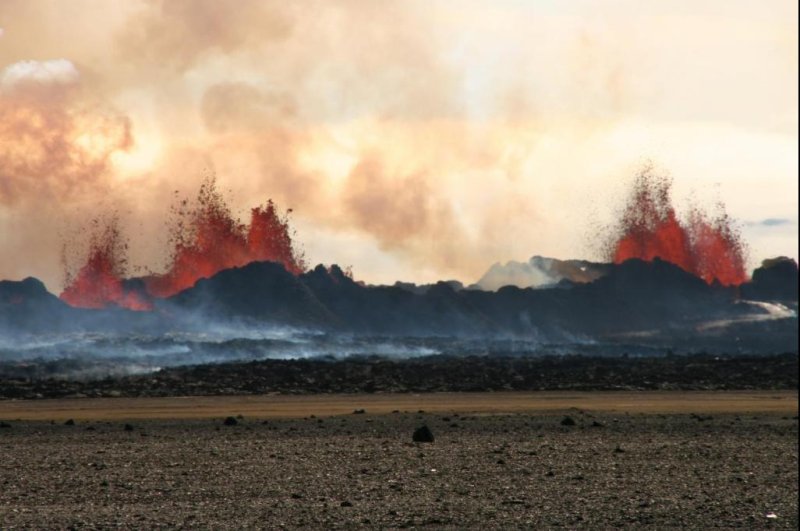The flow of lava from volcanic fissures in Iceland have been described as a smaller version of the eruptions of the Deccan Traps, 65 million years ago. Photo by Michelle Parks/University of Iceland
LEEDS, England, Nov. 23 (UPI) -- Recent studies suggested scientists were beginning to come into agreement on the most likely explanation for disappearance of the dinosaurs some 65 million years ago -- a deadly combination of meteor impacts and prolonged volcanism.
But a new study casts doubt on such certainties, suggesting the jury is still out on the climatic effects of said volcanism and whether or not it was all that dramatic.
The new research, published online this week in Nature Geoscience, looked at ancient evidence of volcanic eruptions to better model how sulphur dioxide emissions might have altered the climate.
"At the time when the dinosaurs reigned, numerous long-lasting eruptions took place over the course of about a million years," lead study author Anja Schmidt, an earth scientist at Leeds University in England, said in a press release. "These eruptions, called 'continental flood basalts' were not like volcanic eruptions we often see today, with lava gushing from the ground like a curtain of fire."
"Each eruption is likely to have lasted years, even decades, and eruptions were separated by periods without volcanic activity," Schmidt added. "The lava produced by an eruption of average intensity would have filled 150 Olympic-size swimming pools per minute."
The signature of these basalts are most obvious on the Deccan Plateau of west-central India, where the Deccan Traps featured layer upon layer of ancient hardened basalt lava turned igneous rock. It is one the largest volcanic features on Earth.
Models, newly developed by Schmidt and his colleagues, suggest sulphur dioxide emissions from the the Deccan Traps and other similar eruptions would have had limited influence on the atmosphere -- much more negligible than the changes other scientists have proffered.
Only if the basalts continued to erupt uninterrupted for hundreds of years would they have had the potential to put the squeeze on plants and animals. But the geologic evidence, Schmidt argues, shows eruptions were intermittent and often separated by long periods of normalcy during which the climate would be able to recover and normalize.
"Perhaps most intriguingly, we found that the effects of acid rain on vegetation were rather selective. Vegetation in some but not all parts of the world would have died off, whereas in other areas the effects would have been negligible," said Schmidt.
The new findings may force scientists to reexamine the significance previous research has placed on volcanism and its role in ending the dinosaurs' planetary reign.
"We now need to better understand how long both the individual eruptions and the periods without volcanic activity lasted," Schmidt concluded.















